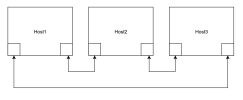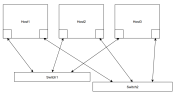I have 3 nodes, and lets assume I have unlimited resources
what is the best way to set up a redundant corosync network?
So far I have tried a point to point mesh network using 2 ports on each device like below

I have also set up the Corosync network through 2 switches like below:
 My question is what are the pros and cons of each configuration, both offer the same redundancy. Will I have latency issues with the mesh network? or is it an advantage as I don't have the running costs of 2 extra switches?
My question is what are the pros and cons of each configuration, both offer the same redundancy. Will I have latency issues with the mesh network? or is it an advantage as I don't have the running costs of 2 extra switches?
This question might have already been asked but i have had a search and can't find anything this specific
what is the best way to set up a redundant corosync network?
So far I have tried a point to point mesh network using 2 ports on each device like below

I have also set up the Corosync network through 2 switches like below:
 My question is what are the pros and cons of each configuration, both offer the same redundancy. Will I have latency issues with the mesh network? or is it an advantage as I don't have the running costs of 2 extra switches?
My question is what are the pros and cons of each configuration, both offer the same redundancy. Will I have latency issues with the mesh network? or is it an advantage as I don't have the running costs of 2 extra switches?This question might have already been asked but i have had a search and can't find anything this specific

